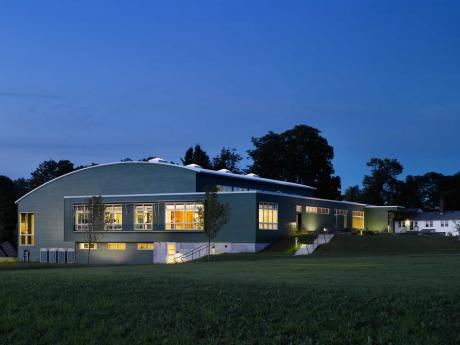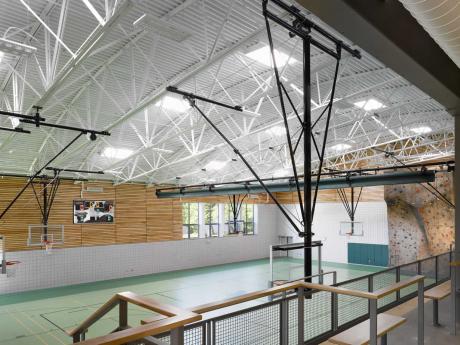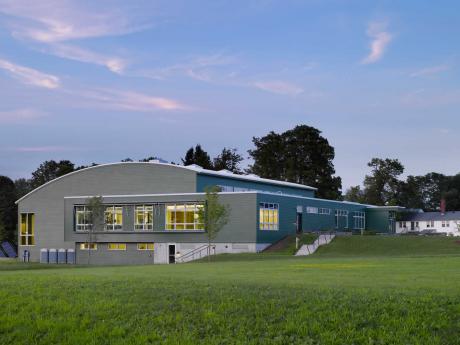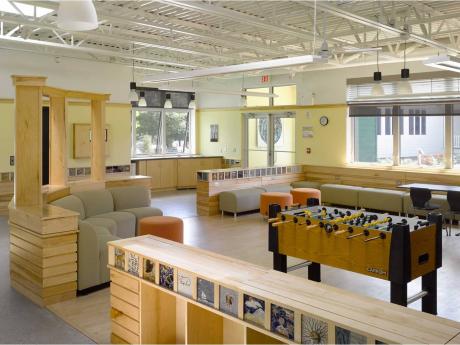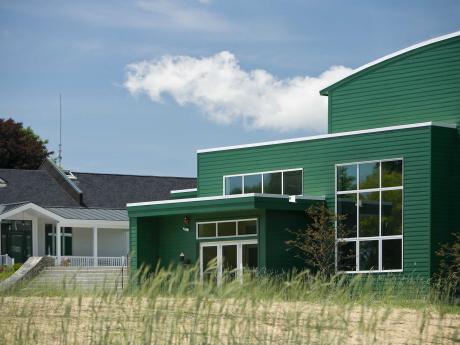The Putney School Field House
Project Photo Gallery
Project Team
“This is not just a gym…We want this to be a place where our students can learn about being environmentally responsible, so that later in life, when they are making choices, they can say, ‘It’s possible. Our gym at school did it this way’.” – Randy Smith, Putney School
The design process for the Putney School Field House started from the client’s request, to design the highest quality environmental building within their budget. The team modeled and evaluated a range of energy and environmental building alternatives, comparing construction costs, 30-year operating costs and CO2 emission.
Some options were removed from consideration almost immediately because they did not go far enough in reaching the School’s sustainability goals. The net-zero option gained final approval from the school. From the School’s perspective it seemed much easier to raise the extra money needed for the construction of a model building than for an endowment for ongoing operating costs for a less-efficient building. The School also decided to seek platinum LEED certification for the project to confirm their efforts with third-party verification.
Throughout the design process, Maclay Architects, working with the design team, conducted multiple day-long work sessions with students, faculty and staff, focusing on key design points. While these sessions added time, voices and viewpoints to the design process, they allowed for a building that speaks of and to the school community. Upon completion, educational signage was placed throughout the building to explain the unique building features and enhance the experience of visitors through learning.
Super-insulation and extensive air sealing were integral to reducing the energy consumption of the facility. To reduce heating energy use by 77% compared to the ASHRAE Standard 90.1-2007 baseline building (Appendix G), the following high insulative levels were used: R-60 roof, R-45 walls above grade, R-20 slabs, R-20 foundation walls below grade and R-5 windows. Through careful design and execution the building achieved a tested air leakage rate of 0.065 cfm/sq ft. of above ground building shell at 50 pascals test pressure or 1,625cfm-50 total air leakage rate.
Consideration of mechanical systems included both ground-source and air-source heat pumps. Though the air-source system was less efficient than the ground-source system, the solar panels required to cover this inefficiency required less investment than the difference of cost the systems. Based on the cost and the simplicity of the system, the school chose to install the air-source system. To achieve the zero energy goal an investment in renewable on site renewable energy systems included 36.8 kW of solar tracking collectors installed to the north of the Field House.
Construction on the Putney School Field House began in 2007 and was completed in October 2009. The 16,800 square foot Field House is New England’s first net-zero athletic building and received LEED Platinum certification from the U.S. Green Building Council.
Quick Facts
General
| Location | Putney, Vermont |
|---|---|
| Building Type | Athletic Facility and Gathering Space |
| Project Type | |
| Basis of Performance Claim | |
| Conditioned Floor Area | 16,814 sq ft |
| Total Cost of Project | $5,106,000 |
Energy Summary
| Energy Data Type | |
|---|---|
| Renewable Energy System Type(s) | |
| Ratings |
Envelope and Mechanicals
| Subslab assembly |
4” EPS under whole slab |
|---|---|
| Foundation wall assembly |
2” EPS panel to 48” depth |
| Above grade wall assembly |
gym wall: 17” of cellulose insulation, all other spaces: 8” of cellulose and 2” of Poly-isocyanurate |

